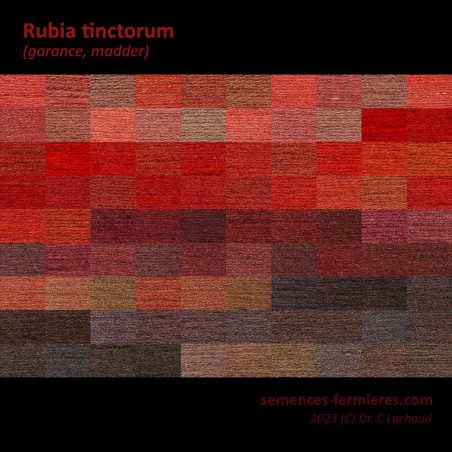



















-
Perennial growing back each year in Spring from a stock of fleshy roots that lignify with age
Fragile stems unable to support themselves, little or not branched, square section, with small hooked spines which cling to clothing, 1.5 to 2 m long
Uninterrupted growth from spring to fall
Upright habit when the plant finds a support in which to grow, lying down otherwise
Leaves united by 4 (to 6) in whorls evenly spaced along the stems
They are soft green to bright green, slightly leathery, and like the stem, have small hooks allowing them to grip
Flowers tiny, greenish-yellow star with 5 petals, united in loose racemes at the end of the stems
Blooms from early summer to early fall, followed by small - green then black - berries, each containing a large seed
The root contains several dye chemicals, including Alizarin which provides magnificent reds for Dyeing and Fine Arts
Dyeing power is independent of the age of the plant, but the produced biomass increases year by year
(according to ISBN 978-0-470-51199-2 pp. 43-44: "The dye content does not change during this time, but the dry mass yield increases continually from year to year")
This is why harvest is usually done after 2 or 3 years in cultivation - however it is possible to harvest on the year of sowing after 6 months of cultivation only
-
| Jan | Feb | Mar | Apr | May | Jun | Jul | Aug | Sep | Oct | Nov | Dec | ||
|---|---|---|---|---|---|---|---|---|---|---|---|---|---|
| Z6 | |||||||||||||
| etc. | |||||||||||||
Sow in March in deep pots so that the roots can develop well, in a mixture of loam and potting soil, warm and in the sun, under shelter from frost
Quick germination
Young plants are often eaten by slugs, take all precautions
For Multiannual Cultivation in open ground
End of May or beginning of June, when the plants are sufficiently developed, transplant in open ground at a sunny place, in a soil well loosened and enriched with manure compost
Water regularly the first year when necessary, while the plant takes hold
Weed regularly
Cut off dead parts in winter
Cultivate 2 to 3 years before harvest
For Annual Cultivation in pots
Plant several plants in very large pots (wide and high), in a mixture of loam (1/3), potting soil (1/3) and manure compost (1/3)
Place in full sun
Water regularly
During the summer, add liquid fertilizer regularly
-
Plants cultivated for several years in the ground
Extract the stump and the network of fleshy roots in the fall of the 3rd year
Try not to lose too many roots (they break easily and get lost in the ground)
Plants grown in pots
Turn the pot over to drop the root ball
Then, shake the soil from the roots to remove as much soil as possible, and wash the roots with clean water
Sort them to remove dead or diseased roots
Use immediately or Store
(cut into small sections and dry at 25°C as quickly as possible. Store in this form in a dry, cool and dark place, or grind before storage)
Learn to Dye Madder Root with our Courses:
You might also like
Payment :
PayPal < 150 €
Check < 850 €
Bank Wire > 149 €
Thank you for your kind understanding